Trees with Pink Flowers in Spring (With Pictures) – Identification Guide
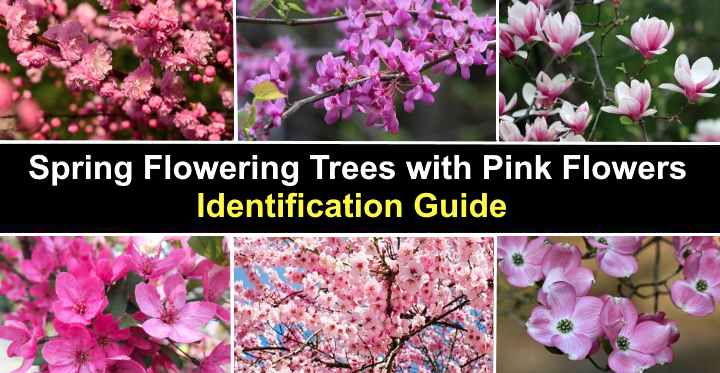
Trees with pink flowers are one of the most beautiful sights in springtime. Spring is a time of renewal and growth, and many trees with pink flowers are the first ones to bloom.
Trees with pink flowers in spring such as the eastern redbud, small cherry blossom, crabapples, flowering dogwoods, and magnolias add a pop of pink color to a garden landscape. Pink flowering trees also offer fragrant aromas that fill backyards with sweet scents.
Flowering trees with pink blossoms can bloom as early as late winter or spring in February or March. By spring, many varieties of pink-flowering trees will be in full bloom, and flowers typically persist during March, April, and May. However, some trees with pink flowers, like the desert willow, produce flowers in late spring that persist through summer.
This article is a guide to the most eye-catching and fragrant trees that bloom in spring with pink flowers. Descriptions and pictures of the vibrant pink blossoms, leaves and the tree’s growth characteristics will help you choose the best spring flowering ornamental trees for your front or backyard.
How to Identify Spring Flowering Trees with Pink Blossoms
To identify trees that blossom in spring, it’s necessary to look at the shape and color of the flowers, leaf type, the tree’s shape, and type of bark. Additionally, look at the color of the flowers. Most of these trees will have bright pink blooms, ranging in shades from whitish-pink to salmon, coral, fuchsia, or deep magenta.
Many varieties of pink-flowering trees are small, decorative trees with ornamental blooms. The dwarf or small trees are suitable for landscaping compact backyards where space is limited. Other larger trees with pink spring blossoms are ideal for shade or privacy.
Types of Trees with Pink Flowers in Spring (With Pictures)
Trees with pink flowers add beautiful shades of color in early spring, sometimes blooming on bare branches. Let’s look in more detail at several ornamental trees with eye-catching, fragrant pink blooms.
Eastern Redbud (Cercis canadensis)
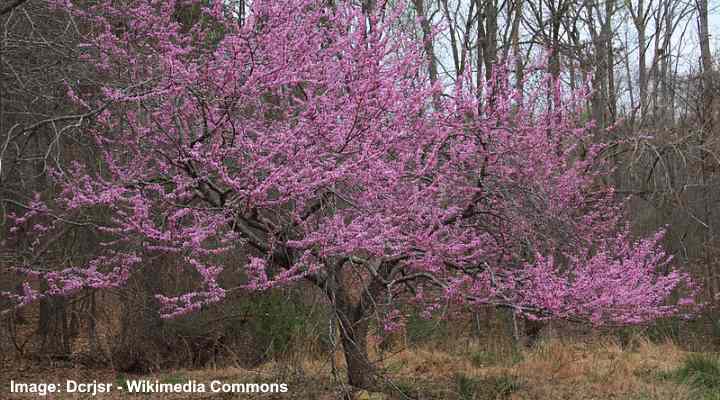
Eastern redbud trees blossom with pink flowers on bare branches in early spring
The eastern redbud is a popular deciduous tree with masses of rosy-pink pea-like flowers blossoming in early spring. The fragrant pink flowers cover bare branches, appearing just before heart-shaped green leaves with a reddish tinge appear. The dramatic pink floral display on zigzagging branches is a spectacular sight in late February or early March.
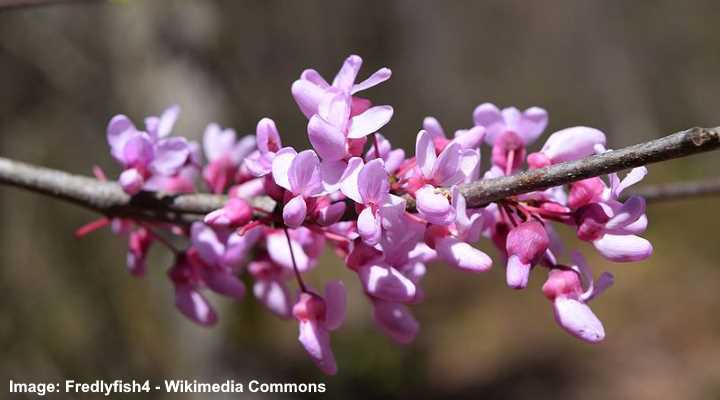
A close up picture of eastern redbud flowers
The eastern redbud grows 20 to 30 ft. (6 – 9 m) tall and has a vase-shaped growth habit spreading up to 35 ft. (10.5 m) wide. Its size makes it suitable for landscaping compact residential backyards. After the pea-like purple-rose flowers bloom, flattened bean-like dry seed pods appear, persisting through winter.
This pink-flowering redbud tree is native to North America and has pale yellow fall colors.
Zone: 4 to 9
Exposure: Full sun or partial shade
Bloom time: Early and mid-spring
Pink Flowering Cherry Trees (Prunus)
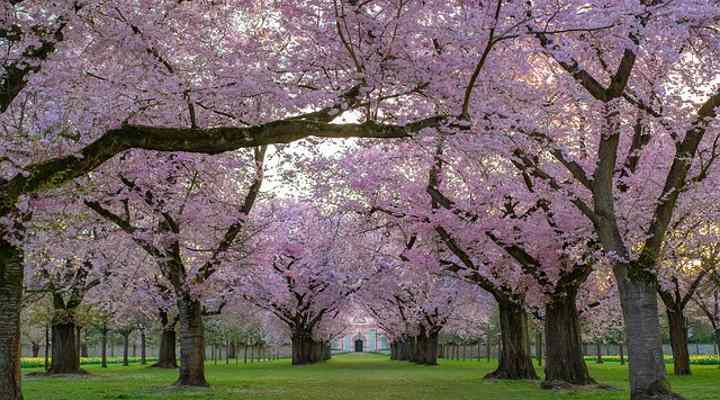
Cherry trees are well known for their stunning flowers that can be white or pink and can be simple 5-petal flowers or double flowers with dozens of petals
Many varieties of cherry blossom trees (sakura) have delightful soft pink to deep pink flowers in the spring. The clusters of cherry blossoms have five-petalled showy flowers. These pink blossoms can be single, semi-double, or double flowers with up to 50 petals on the showiest varieties. Some cherry blossom trees have chrysanthemum-like flowers.
Here are some examples of spectacular ornamental cherry trees with fragrant pink flowers:
Japanese dwarf cherry blossom tree (Prunus serrulata ‘Kiku-Shidare-Zakura’)—This stunning cherry blossom has weeping branches and clusters of showy, double pink flowers. The large chrysanthemum-like flowers can be deep pink, and they beautify drooping stems when blooming in early spring. The dwarf tree grows 10 to 15 ft. (3 – 4.5 m) tall and wide.
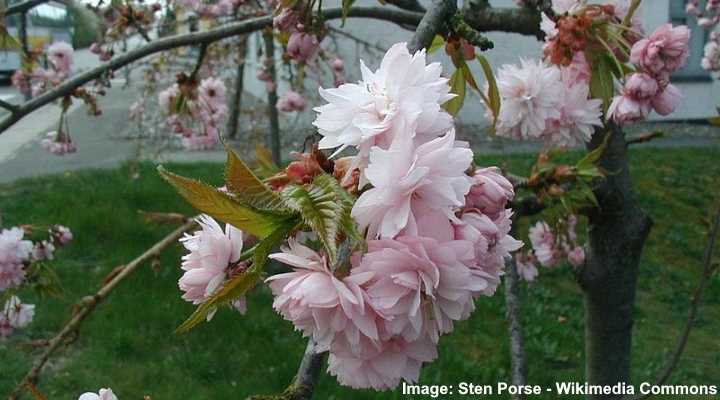
Japanese weeping cherry ‘Kiku-Shidare-Zakura’ has stunning ruffled pink flowers
Pink-flowering dwarf cherry tree (Prunus ‘Kursar’)–This cherry blossom variety has clusters of bell-shaped deep pink and magenta flowers. The spring-blooming tree, with its single flowers, creates an eye-catching floral display at the beginning of spring. The slow-growing cherry tree grows 6.5 ft. (2 m) tall.

Prunus ‘Kursar’ flowers
Hiromi dwarf cherry blossom tree (Prunus jacquemontii ‘Hiromi’)— This small cherry tree has single, pale pink flowers and only grows 3 to 5 ft. tall (1 – 1.5 m). The spring blooming pale pink flowers cover its delicate branches when in full bloom.
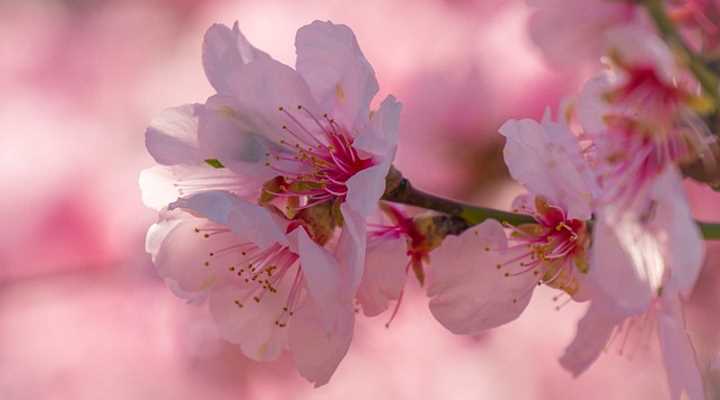
Prunus jacquemontii ‘Hiromi’ flowers
Weeping cherry blossom tree (Prunus x subhirtella ‘Pendula Rubra’)— This weeping cherry tree has cascading branches and clusters of single pale pink flowers. The attractive blooms appear in early spring, creating a stunning floral display. The weeping cherry tree grows 10 ft. (3 m) tall and wide.
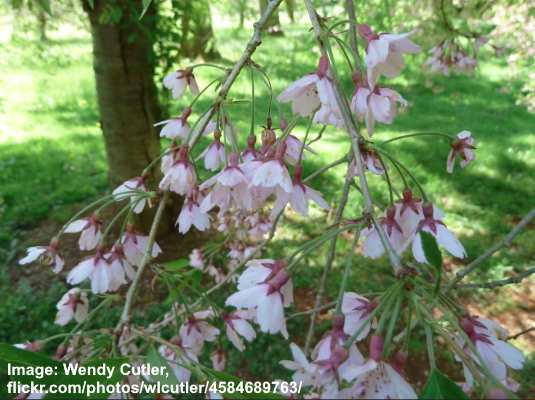
Prunus x subhirtella ‘Pendula Rubra’ flowers
Zone: 4 to 9
Exposure: Full sun
Bloom time: Early spring
Pink Flowering Dogwood (Cornus florida ‘Rubra’)
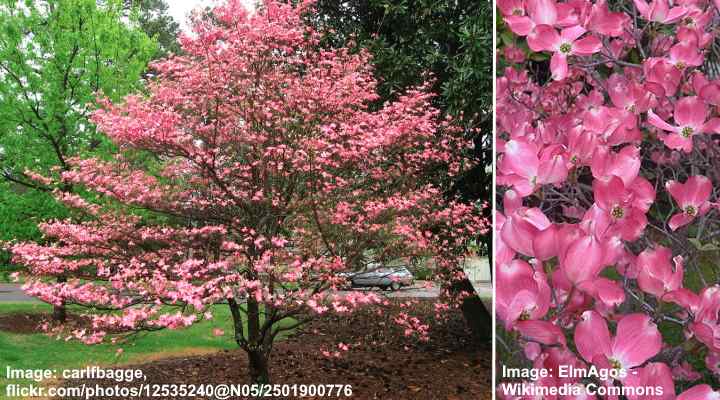
The ornamental dogwood ‘Rubra’ is covered with masses of pink flowers in spring and is a beautiful landscaping tree
Pink-flowering dogwood is a beautiful ornamental tree with abundant pink bracts that look like flowers. This small spring flowering tree has a vase shape. It produces large pink four-petaled flower-like bracts surrounding tiny greenish flowers in the spring. After flowering, ovate leaves and orange-red fruits appear. In fall, this dogwood’s foliage turns attractive scarlet and maroon shades.
Pink-flowering dogwood grows 15 to 30 ft. (4.5 – 9 m) tall and wide. The pink flowers on this native tree persist through spring until early summer. Flowering dogwoods with pink blossoms are regarded as some of the most spectacular landscape trees.
Zone: 5 to 9
Exposure: Full sun or partial partial
Bloom time: Spring
Japanese Dogwood Tree with Pink Flowers (Cornus kousa ‘Rutpink’ and ‘Miss Satomi’)
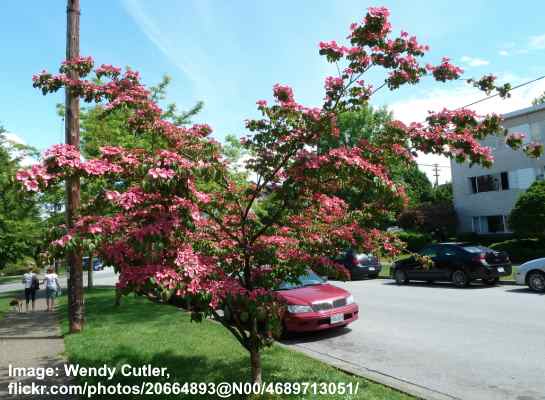
A young Japanese dogwood tree with pink flowers
Two pink-flowering species of Japanese dogwood trees—“Rutpink” and “Miss Satomi”—bloom throughout spring. The large flowers consist of four deep pink to fuchsia oval, pointed bracts. These create a flower 4” to 5” (10 – 12 cm) across in a star shape. In the fall, the deep green foliage turns attractive orange and red shades.
Kousa dogwoods grow 20 to 25 ft. (6 – 7.5 m) tall and up to 20 ft. (4.5 m) wide. Thriving in full sun or part shade, the small decorative trees require organically rich well-drained soil. The colorful pink flowers, dense green foliage with tinges of purple, and interesting shapes give Japanese dogwood trees four-season interest.
Zone: 5 to 8
Exposure: Full sun or partial shade
Bloom time: Throughout spring
Saucer Magnolia (Magnolia x soulangeana)
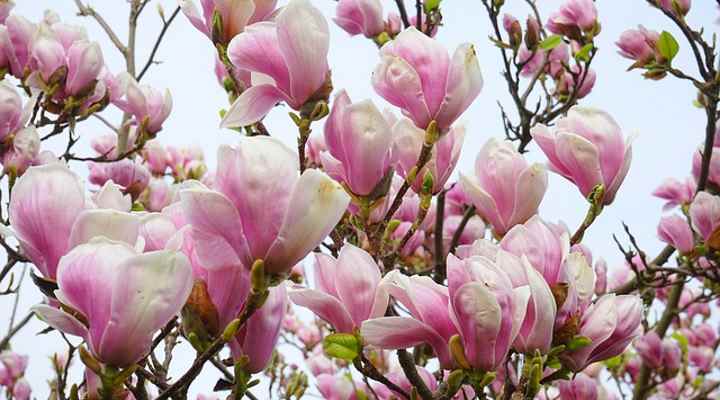
Saucer magnolia has large flowers that come in shades of pink and white, depending on the cultivar
The saucer magnolia is a stunning, deciduous tree producing a profusion of fragrant, deep, rosy-pink or purple-pink flowers in spring. The large cup-shaped pink tulip-like flowers measure up to 10” (25 cm) across. Typically, the outer petals are pink and the inside white—adding to the stunning floral display.
Saucer magnolia is a multi-stemmed shrub-like tree that adds beauty to any garden landscape. Also called tulip magnolia or Chinese magnolia, this small tree grows 20 to 25 ft. (6 – 7.5 m) tall and wide. The huge pink flowers appear mid-spring and persist through summer, followed by bright red fruits.
Saucer magnolia trees grow best when planted in moist, well-drained soils in sunny parts of your yard or garden.
Zone: 5 to 9
Exposure: Full sun or partial sun
Bloom time: Early spring or mid-spring, depending on the cultivar
Tulip Magnolia (Magnolia liliiflora)
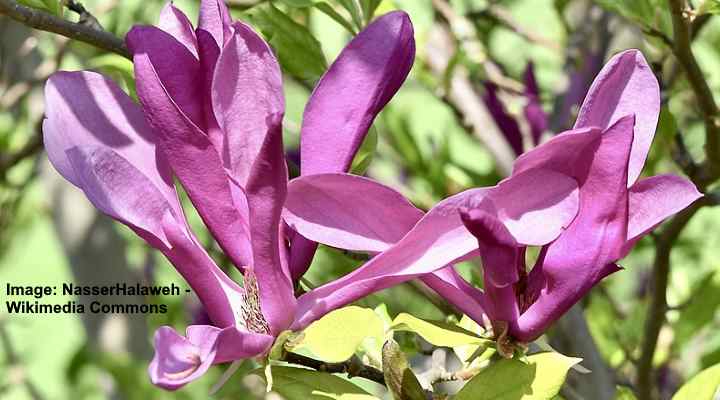
Tulip magnolia blooms with deep pink-purple flowers in late spring
Tulip magnolia is a small tree that blooms with deep pink to purple narrowly-shaped flowers. Like most magnolia species, the tulip magnolia has lily-like flowers—hence the botanical name liliiflora. The dark pink tulip blossoms consist of 9 to 18 petals and are 5” (12 cm) long.
Tulip magnolia is a magnificent specimen tree that creates a focal point in a front or back yard. The flowers bloom in late spring and continue blooming throughout summer. These small pink flowering trees grow 8 to 12 ft. (2.4 – 3.6 m) tall and wide.
Zone: 4 to 9
Exposure: Full sun or partial shade
Bloom time: From late spring through summer
Related reading: How to care for magnolia trees.
Flowering Almond or Plum Tree (Prunus triloba)

Flowering almond or plum tree has masses of pink flower clusters and is suitable for landscaping small gardens
Flowering plum or almond tree is a small shrub-like tree with masses of pale pink spring flowers. After blooming in early spring, this ornamental multi-stemmed flowering tree produces three-lobed leaves, and the pink flowers give way to round red fruits. Because the tree blooms early in spring, its flowers are susceptible to late frosts.
The flowering almond tree grows 10 to 15 ft. (3 – 4.5 m) tall and wide and has a distinct vase shape. The small, beautiful, fragrant rose-like pink flowers are 1.2” (3 cm) across and appear in showy clusters.
Flowering almond trees grow best in full sun or partial shade and moist, well-drained soil. They are ideal for small gardens and make a great addition to any landscape.
Zone: 3 to 7
Exposure: Full sun to partial shade
Bloom time: Early spring
Pink Flowering Crabapple Trees
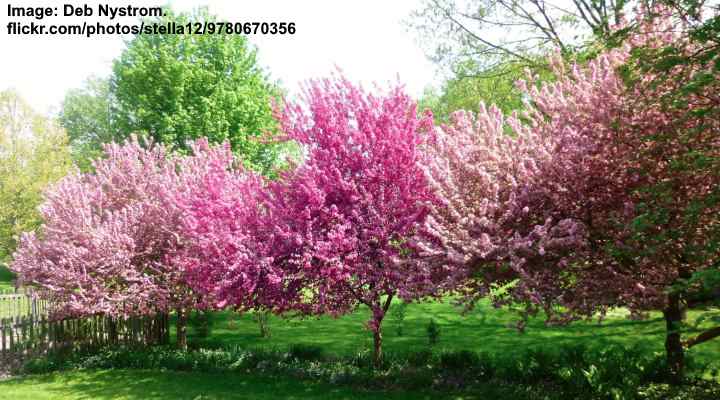
The beautiful spring flowers of crabapple trees come is various pink shades, depending on the cultivar
Crabapple trees are among the most floriferous small trees, with soft pink flowers blooming in mid-spring for four to five weeks. A wide variety of crabapple trees have flowers in shades of coral pink, magenta, pinkish-white, and deep pink. In addition to spectacular clusters of pink flowers, crabapple blossoms have a sweet, exotic fragrance.
Pink-flowering crabapples typically grow between 12 and 30 ft. (3.6 – 9 m) tall and wide. After the pink spring blossoms have passed, clusters of small colorful pomes or apples appear. These tiny cherry-like fruits can be yellow, pink, or red. Many crabapple species have attractive fall colors when the green foliage turns reddish-purple.
Zone: 4 to 8
Exposure: Full sun
Bloom time: Mid-spring and bloom time lasts up to five weeks.
Red Horse Chestnut (Aesculus x carnea)
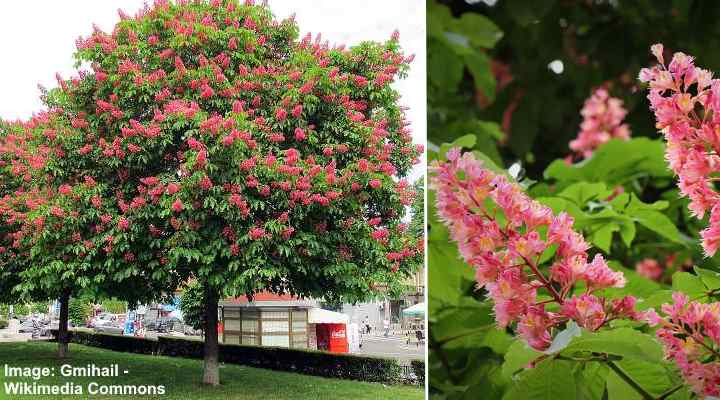
Red horse chestnut tree blooms with conical deep pink flower clusters in late spring
Red horse chestnut is a mid-sized deciduous tree with conical clusters of rose-red or deep pink flowers appearing in late spring. The individual pink-colored flowers are funnel-shaped and have yellow throats. These pink and red hues contrast nicely with the palmately compound green leaves that measure 4” to 8” (10 – 20 cm) across.
Red horse chestnut trees grow 30 to 40 ft. (9 – 12 m) tall and wide. After the pinkish-red cone-shaped panicles finish blooming in mid-summer, large spiky seed capsules appear, each containing two or three brown nuts. Due to their large size and spreading canopy, red horse chestnuts are ideal shade trees for large gardens.
Zone: 5 to 8
Exposure: Full sun or partial shade
Bloom time: Late spring
Spring Flowering Crape Myrtle Trees (Lagerstroemia)
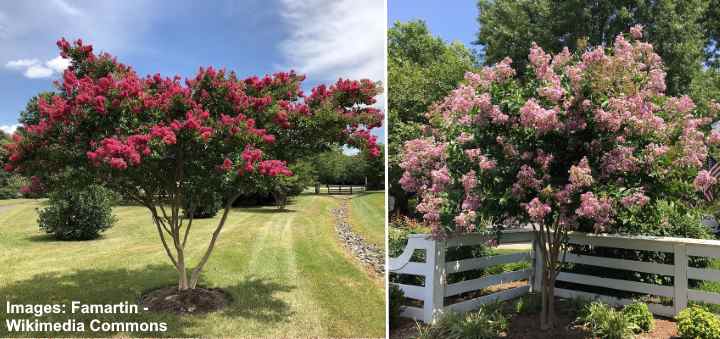
Crape myrtle are shrub-like trees with multiple stems and flowers in shades of red, pink, purple and white colors
Crape myrtle is a large shrub or small tree with stunningly beautiful pink crinkly blossoms in spring. This colorful ornamental tree will give your garden an explosion of wonderful spring colors and aromas. The ruffled pink flowers grow in large clusters and appear in late spring or early summer.
With its elegant, showy clusters of blooms in shades of pink, white, purple and red, crape myrtle grows 8 to 15 ft. (2.4 – 4.5 m) tall and up to 10 ft. (3 m) wide. The late-blooming tree keeps its flowers throughout the summer. The specimen trees are low-maintenance, and their size means they are a perfect choice for big and small yards.
The crape myrtle cultivar that blooms in late spring is Lagerstroemia ‘Early Bird.’ The small shrub-like tree has masses of pale pink crinkly flowers blooming on arching branches.
Apart from growing as a small ornamental tree, crape myrtle shrubs are ideal as foundation plantings, an informal hedge, or a privacy screen.
Zone: 7 to 9
Exposure: Full sun
Bloom time: Late spring or early summer
Related reading: How to care for crape myrtle trees.
Orchid Tree (Bauhinia variegata)
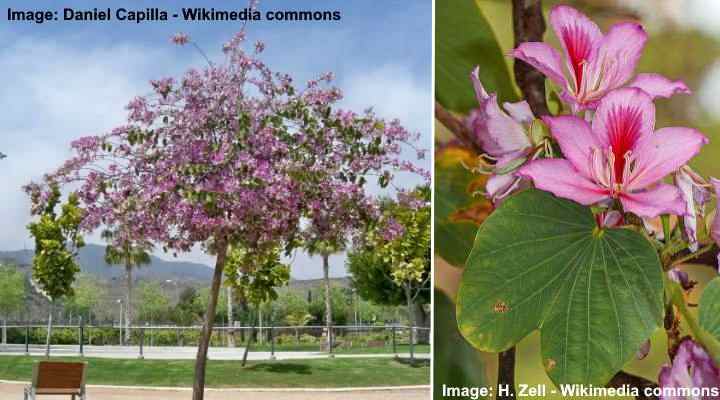
The orchid tree blooms in warmer zones with beautiful pink blossoms in late winter or early spring
The orchid tree is a beautiful exotic tree that bursts into life in early spring with pink tropical flowers. The stunning pink flowers have several large petals forming an open flower 2” to 3” (2.5 – 7 cm) across. These early-blooming blossoms contrast the densely growing green leaves that form a spreading canopy.
Sun and heat-loving orchid trees are an excellent addition to any garden or patio in warm winter zones. The semi-evergreen tree grows 20 to 35 ft. (6 – 10 m) tall and wide. After emerging in spring, the pinkish flowers give way to long, sharp-beaked seedpods measuring 12” (30 cm).
Zone: 9 to 11
Exposure: Full sun or dappled sunlight
Bloom time: Late winter or early spring
Cherry Plum Tree (Prunus cerasifera)
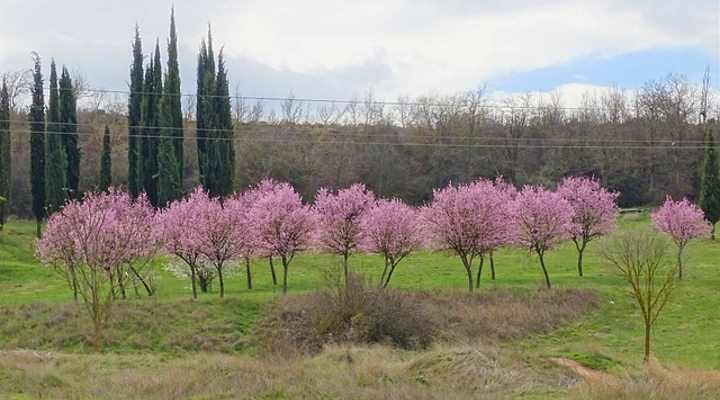
Cherry plum trees are beautiful ornamental pink flowering trees in any landscaped garden
The cherry plum tree is an ornamental mid-sized tree covered in a flurry of beautiful pink flowers in mid-spring and summer. The dainty flowers have five rounded white to pale pink petals surrounding a deep pink center. Another ornamental feature of the cherry plum tree is its dark reddish-purple foliage.

Cherry plum flowers
As an attractive ornamental landscape tree, the purple-leaf cherry plum is perfect as a privacy screen, flowering backdrop, hedge, or specimen plant. It grows 15 to 20 ft. (4.5 – 6 m) tall and wide. Additionally, this fast-growing tree is suitable for use in small garden spaces. The purple leaves turn red in the fall.
Zone: 4 to 8
Exposure: Full sun or partial sun
Bloom time: Mid to late spring
Flowering Peach Tree (Prunus persica)
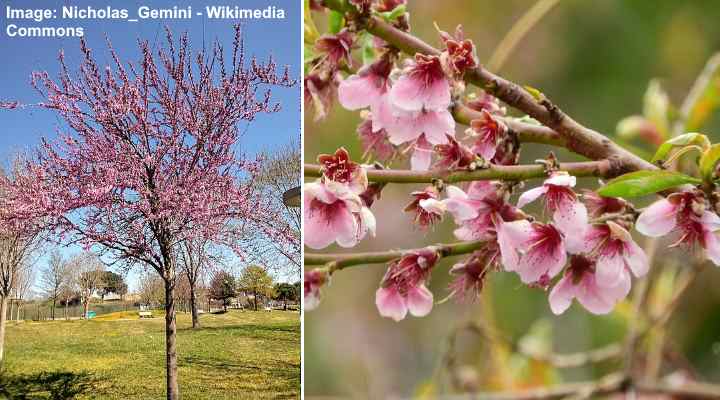
The stunning pink flowers of peach tree bloom in early spring before the leaves
The flowering peach tree is a deciduous spring-flowering tree with stunning pink flowers. Apart from being an ornamental tree with pink flowers, this peach tree has lush summer foliage, juicy fruits in mid to late summer, and outstanding yellow fall colors. The bright pink blooms cover the tree for two weeks in early to mid-spring.
Flowering peach trees grow 15 to 25 ft. (4.5 – 7.5 m) tall. The beautiful fruit trees thrive in temperate and mild zones. Although they require 750 chill hours to produce fruit, late spring frosts can kill the pink blossoms. However, the ornamental flowering peach trees can provide dramatic pink showy blossoms year after year without much care.
Zone: 4 to 9
Exposure: Full sun or partial shade
Bloom time: Early spring
Desert Willow (Chilopsis linearis)
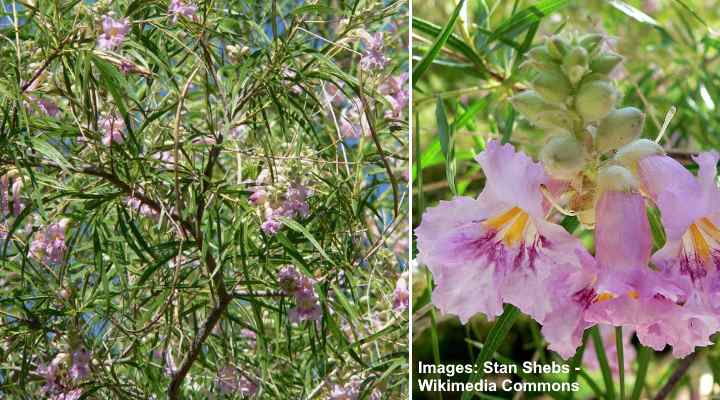
The desert willow blooms with attractive pink flowers in late spring and is suitable for arid landscapes
Desert willow is a small deciduous ornamental tree with trumpet-shaped, fragrant pink flowers. The attractive flowers have ruffled petals with deep purple to magenta and yellow throats. These sweetly fragrant pale pink or pale violet flowers contrast with the deep green, linear willow-like leaves. Desert willow trees bloom profusely from late spring through summer until fall.
The deciduous flowering desert tree or shrub grows 15 to 30 ft. (4.5 – 9 m) tall and 10 to 20 ft. (3 – 6 m) wide. Identifying features of this pink-flowering tree are its twisted branches, shaggy, peeling bark, and fast growth. It’s also a drought-tolerant tree for arid landscapes.
Zone: 7 to 11
Exposure: Full sun
Bloom time: Late spring, summer, and early fall
Pink Trumpet Tree (Handroanthus heptaphyllus)
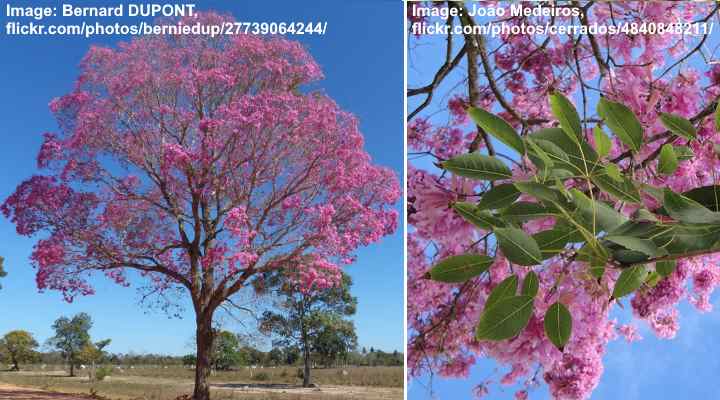
The pink trumpet tree has decorative pink blossoms in early spring on bare branches
The pink trumpet tree is a stunning deciduous tree with pink tubular flowers blooming in early spring. The pink trumpet trees look spectacular in a landscape with their conical, rounded crown and pink flowers on bare branches. These are followed by large elliptical green leaves. After blooming, the pink trumpet-like flowers give way to long seedpods 12” to 15” (30 – cm) long.
The pink trumpet tree grows up to 20 to 30 ft. (6 – 9 m) tall and up to 25 ft. (7.6 m) wide. Its spring blossom colors range from pale pink to vivid pink or pure white. It drops its lush foliage in the fall, ready to produce another spectacular floral display the following spring. The pink trumpet tree is a popular flowering tree for South Florida backyards.
Zone: 10 and 11
Exposure: Full sun
Bloom time: Early spring
Western Redbud (Cercis occidentalis)
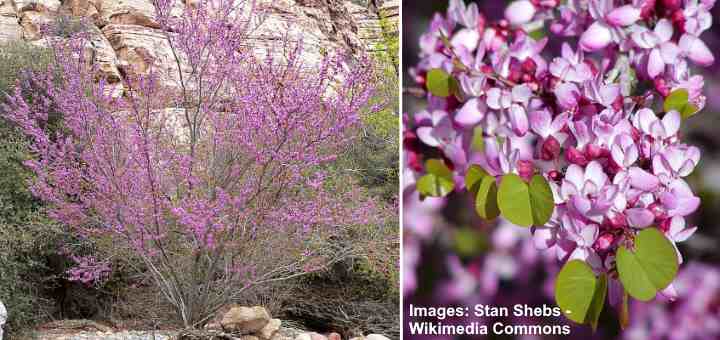
The western redbud is an attractive ornamental tree with pink flowers that bloom in early spring for 2 to 3 weeks. This small flowering tree has a round canopy shape with bright green, heart-shaped leaves that turn bright red and golden yellow in the fall. After blooming in early spring, the western redbud produces slender, elongated seed pods with a distinct brown-purple tinge.
Another identifying feature of the western redbud is its compact, zig-zagging growth pattern. The western redbud can grow up to 10 to 15 ft. (3 – 4.5 m) tall and wide. It can be planted in a variety of soil types and is drought-tolerant once established. This spring-blooming tree is a perfect choice as a specimen plant, focal point, or shrub border.
Zone: 6 to 9
Exposure: Full sun to partial shade
Bloom time: Early spring
Black Lily Magnolia (Magnolia liliiflora ‘Nigra’)
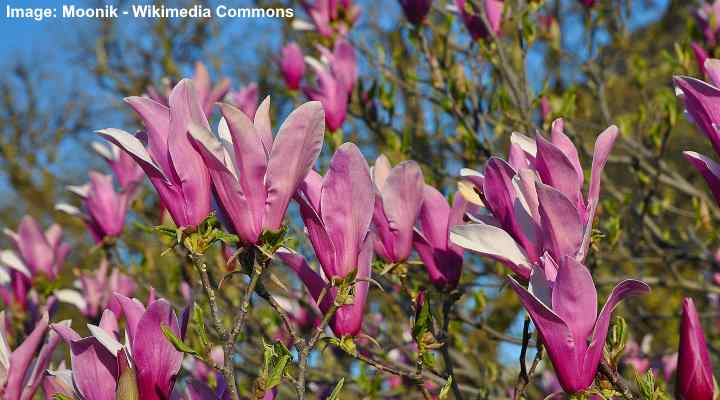
Black Lily magnolia have deep pink tulip-shaped flowers
The black lily magnolia is a deciduous, ornamental tree that produces dark pink-purple lily-like flowers. This tree starts blooming during late spring and continues to sporadically bloom throughout the summer. In addition, this tree has shiny, dark-green leaves that are elliptic in shape.
Reaching a height of only 8 to 12 feet (2.4 – 3.6 meters), the spring-blooming black lily magnolia is ideal for compact spaces. To ensure optimal growth, plant these trees in slightly-acidic, well-drained soil. The black lily magnolia can thrive in full to partial sun, making it a versatile and attractive addition to any garden or landscape.
Zone: 5 to 9
Exposure: Full sun to partial sun
Bloom time: Late spring
Purple Leaf Plum ‘Nigra’ (Prunus cerasifera ‘Nigra’)
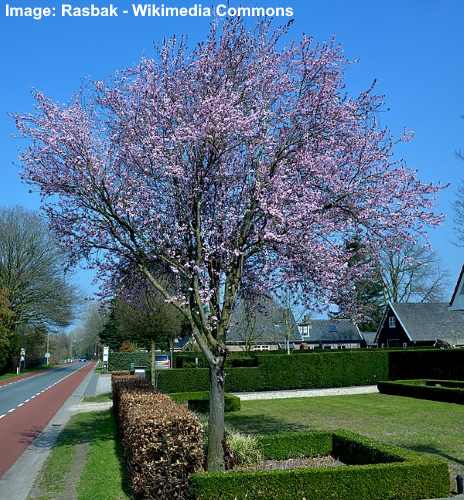
Prunus cerasifera ‘Nigra’
The purple leaf plum is a medium-sized deciduous tree with star-shaped, pale-pink flowers that bloom from early to mid-spring. After the spring blooming period ends, the tree may produce small, plum-like yellow or red edible fruits. The tree also showcases dark purple leaves and twigs, adding to its visual appeal.
The purple leaf plum can reach a height and width of up to 15 to 20 ft. (4.5 – 6 m). Its small size makes it ideal for front or backyards with limited space. For the best growth, plant this tree in moderately fertile soils that are well-draining. Whether used as a striking specimen plant, a flowering hedge, or a privacy screen, the ‘Nigra’ purple leaf plum brings beauty and functionality to your outdoor space.
Zone: 4 to 9
Exposure: Full sun produces the darkest foliage colors
Bloom time: Early to mid spring
Pink-Flowering Fringe Tree (Loropetalum chinense var rubrum ‘Sizzling Pink’)
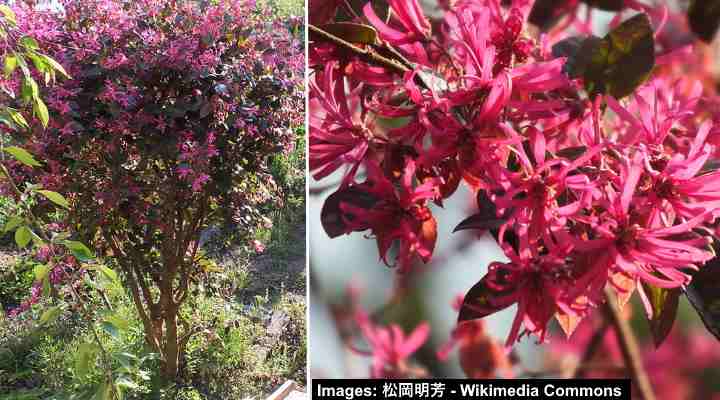
The pink-flowering fringe tree is an attractive, evergreen shrub that produces sweet-smelling, spider-like flowers in a rich pink hue. In late spring, the tree’s canopy is covered with flowers, filling the air with a pleasant scent. This miniature tree also has leaves that emerge with a bronze-like color and eventually transform into a beautiful purple-green shade.
The pink-flowering fringe tree can reach heights of up to 6 to 8 ft. (1.8 – 2.4 m). Grow in well-drained soil for the best results. This tree is versatile, suitable for use as a specimen tree, in foundation plantings, or in small groupings. With its attractive flowers and beautiful foliage, this spring-flowering tree brings a touch of beauty to any garden setting.
Zone: 7 to 9
Exposure: Full sun to partial shade
Bloom time: Spring
Texas Redbud Tree (Cercis canadensis var. texensis)
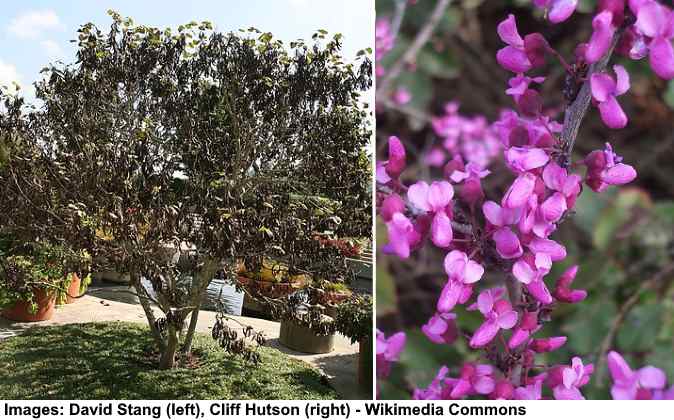
Texas Redbud (Cercis canadensis var. texensis)
The Texas redbud is a deciduous spring-flowering tree characterized by its vibrant, pinkish-purple pea-like flowers. In early spring, the branches are covered in blossoms that persist for around two weeks. The tree is identifiable by its glossy, heart-shaped leaves that transition into a beautiful yellow hue during autumn.
The Texas redbud can reach a height of up to 12 to 18 ft. (3.6 – 5.5 m). It is adaptable to a range of different soil types, such as clay, loamy, and sandy soils. This ornamental tree is an excellent option for urban gardens, shrub borders, or as a focal point. This tree’s relatively compact size makes it an excellent option for smaller gardens.
Zone: 6 to 9
Exposure: Full sun or partial shade
Bloom time: Early spring
Eastern Redbud ‘Forest Pansy’ (Cercis canadensis ‘Forest Pansy’)
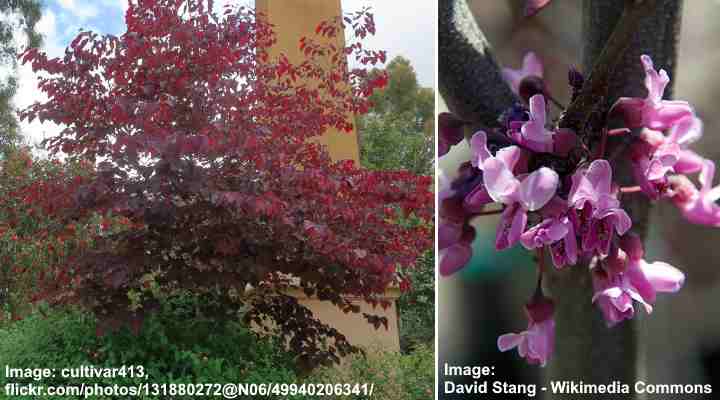
The eastern redbud ‘Forest Pansy’ is an attractive, deciduous tree that produces pea-like, bright pink flowers during early spring. This spring-flowering tree’s blossoms attract pollinators such as bees and butterflies. The blossoms remain on the tree for a couple of weeks, eventually giving way to heart-shaped, reddish-purple leaves.
The eastern redbud ‘Forest Pansy’ can reach a height of around 20 to 30 ft. (6 – 9 m). The tree’s wonderful vase shape and attractive foliage make it a good choice as a landscape tree. It can also be used as a specimen tree, focal point, or shade tree. To ensure optimal growth, plant in moderately-fertile, well-draining soil.
Zone: 5 to 9
Exposure: Full sun to partial shade
Bloom time: Early spring
Susan Magnolia (Magnolia Susan)
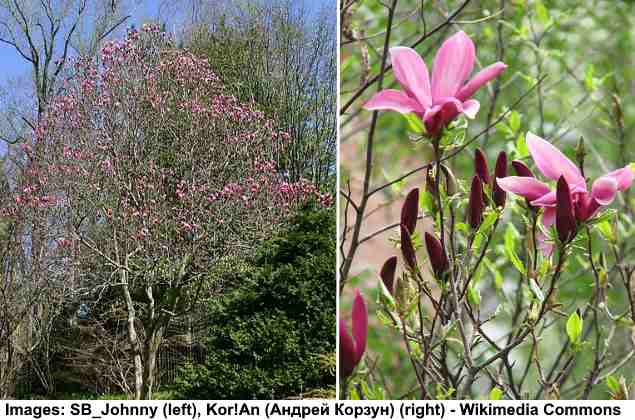
The Susan magnolia is a slow-growing, dwarf tree identified by its beautiful, cup-shaped pinkish-purple flowers. This tree typically blooms in mid to late spring. However, it might also bloom sporadically after that if the conditions are right. The leaves of this tree are large and oval, featuring a medium-green shade that contrasts beautifully with the pink blooms.
The Susan magnolia can reach a height and width of up to 8 to 12 ft. (2.4 – 3.6 m). The tree is adaptable to many soil types but prefers organically rich, well-drained soil. Its spectacular blooms make it a great focal point or specimen plant.
Zone: 3 to 8
Exposure: Full sun to partial shade
Bloom time: Mid to late spring
Burgundy Desert Willow (Chilopsis linearis ‘Burgundy’)
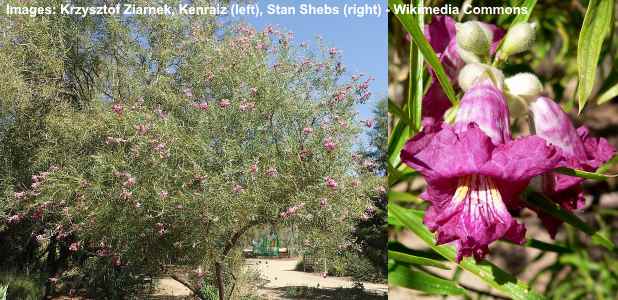
The burgundy desert willow is known for its bright pink, trumpet-shaped flowers that cover the tree during late spring and early summer. The tree’s flowers release a delightful scent that attracts hummingbirds and butterflies. Other identifying features of this tree are its narrow, willow-like leaves and airy foliage.
The burgundy desert willow can reach heights of 15 to 20 ft. (4.5 – 6 m). This spring-blooming tree is also known for its tolerance to drought, heat, and full sunlight. Plant this low-maintenance tree to add a vibrant splash of color to your landscape.
Zone: 7 to 9
Exposure: Full sun
Bloom time: Late spring and early summer
Judas Tree (Cercis siliquastrum)
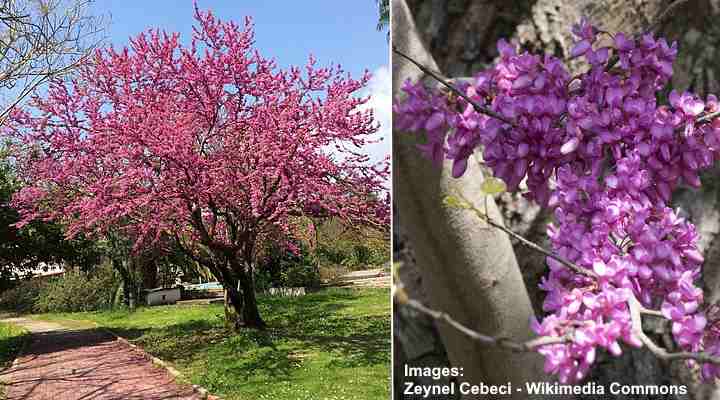
The Judas tree is an ornamental, multi-trunked tree renowned for its stunning clusters of pea-like, rose-pink flowers that bloom in early spring. The beautiful flowers bloom in masses, creating a stunning display that envelops the rounded canopy of the tree. The tree has rounded, heart-shaped leaves that start red and then transition into a vibrant yellow during the fall. In late summer, it produces pendulous, purple-red seed pods, which may persist until winter.
The Judas tree can reach a height of up to 15 to 25 ft. (4.5 – 7.5 m). To ensure the best growth, plant this tree in well-drained soil. Its beautiful flowers and decorative seed pods make it an excellent choice as a specimen tree or a striking focal point in any landscape.
Zone: 6 to 9
Exposure: Full sun or partial shade
Bloom time: Early spring
Pink Shower Tree (Cassia grandis)
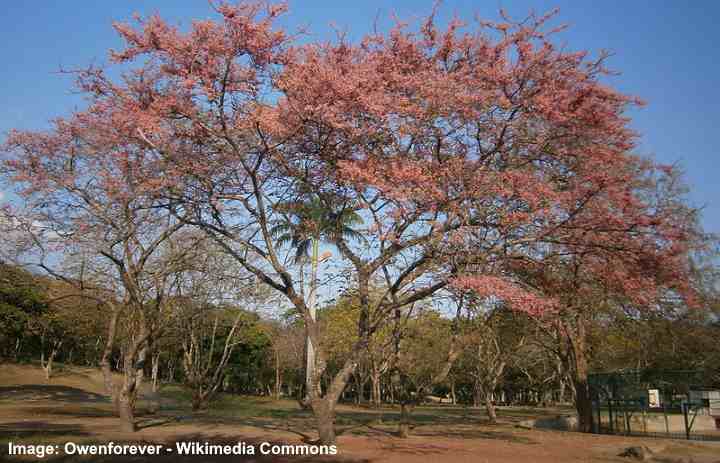
The pink shower tree is a sizable, tropical deciduous tree that produces large clusters of whitish-pink flowers during late spring. The tree is known for its spreading canopy, elliptical, pinnate leaves, and elongated seed pods. This spring-blooming tree is fast-growing and sheds its leaves in the winter months.
The pink shower tree can reach heights of up to 40 to 60 ft. (12 – 18 m). For best results, plant this tree in rich, well-draining soil. This tree is also known for its resistance to drought and shade. The pink shower tree’s beautiful flowers and expansive canopy make it an excellent choice as a specimen tree, shade tree, or striking focal point.
Zone: 10 to 12
Exposure: Full sun to partial sun
Bloom time: Late spring
Japanese Snowbell ‘Pink Chimes’ (Styrax japonicus ‘Pink Chimes’)

The Japanese Snowbell ‘Pink Chimes’ is an exquisite, small evergreen tree known for its beautiful clusters of whitish-pink flowers. The bell-shaped flowers hang gracefully from the branches and bloom in mid to late spring. It also has oblong-shaped, glossy dark-green leaves that turn a stunning orangish hue in the fall.
The Japanese Snowbell ‘Pink Chimes’ is small, growing to a maximum height of only 15 to 20 ft. (4.5 – 6 m). This tree prefers acidic, well-draining soil. Its compact size makes it perfect for adding a tropical touch to smaller spaces.
Zone: 5 to 8
Exposure: Partial shade
Bloom time: Mid to late spring
Royal Empress Tree (Paulownia tomentosa)

The royal empress tree is a medium-sized, fast-growing tree that blooms with large, pinkish-lavender bell-shaped flowers in the spring. The pink hues of the flowers contrast nicely with the large, heart-shaped, green leaves. Another identifying feature of this tree is its woody, brown seed capsules, which are produced after the blooming period.
The royal empress tree can reach a height of 30 to 80 ft. (10 – 25 m). It is tolerant of drought and a variety of soil types, though it prefers moist, well-drained soil. This tree’s striking blossoms make it a great focal point or specimen plant in medium-sized landscapes.
Zone: 5 to 9
Exposure: Full sun or dappled shade
Bloom time: Spring
Mimosa Tree (Albizia julibrissin)
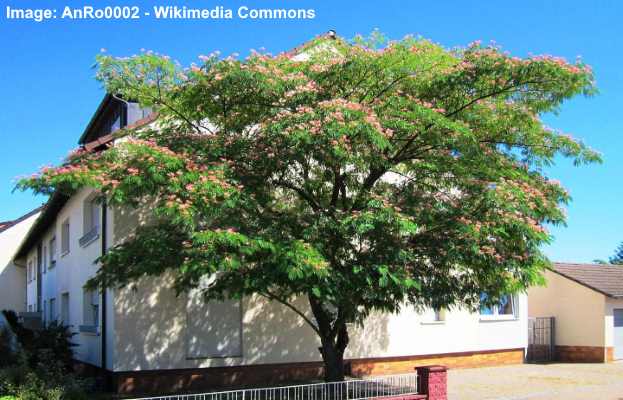
Mimosa Tree (Albizia julibrissin)
The mimosa tree is an exquisite, medium-sized deciduous tree that produces pink, fluffy flowers in late spring to early summer. Other identifying features of this tree are its fern-like, deep-green leaves and flat, bean-like seed pods.
The mimosa tree can reach a height of up to 20 to 40 ft (6 – 12 m). It grows well in free-draining soil that is rich in organic matter. Its broad, umbrella-shaped canopy makes it a good choice for a shade tree. Additionally, its exquisite flowers and appealing shape make it a great focal point or specimen plant in parks or public areas.
Zone: 6 – 9
Exposure: Full sun
Bloom time: Late spring to early summer
Related articles:
